Buddhist Mountain Monasteries in Korea
Beopjusa Temple
Beopjusa Temple
Introduction
Natural Environment
History
Temple Layout
Cultural Properties
Information
Natural Environment of Songnisan Mountain
- Songnisan Mountain is situated at the midpoint of the Sobaeksanmaek Mountain Range, extending southwest from the Taebaeksanmaek Mountain Range, crossed by the Baekdudaegan Mountain Range north to south, while Hannamgeumbuk Vein branches off of Cheonwangbong Peak. As for the administrative division, it is located on the boundary of Boeun-gun and Goesan-gun in Chungcheongbuk-do Province and Sangju-si in Gyeongsangbuk-do Province.
This area is renowned as one of the top 8 scenic sites in Korea, and it was designated as a national park in March 1970. Also, it was designated as a historic site and scenic site in June 1964, and designated as Scenic Site No. 61, separate from Beopjusa Temple, in December 2009. From the historical perspective, it began to be called Taebongsan Mountain after the Placenta Chamber of King Sunjo, the 23rd King of Joseon, became enshrined here. On the trail to Sesimjeong, a prohibition sign against the felling of trees issued by the royal family of the Joseon Dynasty still remains, which shows that its temple site and forests have been preserved under the protection of the royal family. -
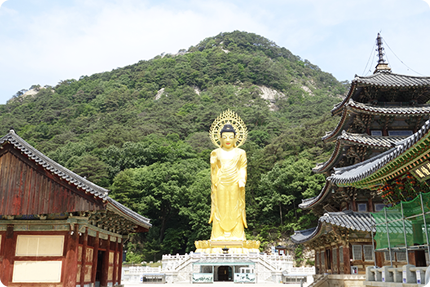 Colossal statue of Maitreya (Yonghwabojeon Hall) and Sujeongbong Peak
Colossal statue of Maitreya (Yonghwabojeon Hall) and Sujeongbong Peak
- The main peak is Cheonwangbong at 1,057m in elevation. Other peaks include Birobong, Gilsangbong, Munsubong, Bohyeonbong, Gwaneumbong, Myobong, and Sujeongbong, and there are stone platforms including Munjangdae, Ipseokdae, Gyeongeopdae, Baeseokdae, Haksodae, Sinseondae, Bonghwangdae and Sanhodae. Of these, Sunjeongbong and Gwameunbong peaks serve as the backdrop of Yonghwabojeon (Mireuk or Maitreya Sutra) and Daeungbojeon (Hwaeom or Flower Garland Sutra) halls and blend beautifully with the temple layout unique to Beopjusa Temple.
-
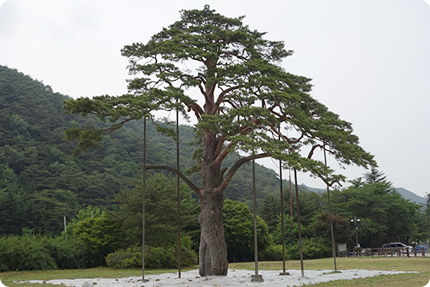 Jeongipum Pine (Natural Monument No. 203)
Jeongipum Pine (Natural Monument No. 203)
-
There are many other famous sites including Eunpokdong Valley, Mansu Valley, Hwayangdong Valley, Seonyudong Valley, Ssanggok Valley, Jangga Falls and Osong Falls. Magnificent scenery can be enjoyed throughout the year thanks to the four distinct seasons.
It serves as a habitat for 1,055 plant species including the Jeongipum pine tree (Natural Monument No. 103) and Korean berchmia (Natural Monument No. 207) as well as 1,831 animal species including rare species such as the great black woodpecker (Natural Monument No. 242) and the flying squirrel (Natural Monument No. 328). Thus, it is considered a “repository of natural resources and wildlife.”
Songnisan has been called by numerous names in the past including Gwangmyeongsan, Jimyeongsan, Mijisan, Gubongsan, Hyeongjesan, Sogeumgangsan, and Jahasan. Songni, in particular, means “to leave the secular world,” and it is believed to have arisen from the story regarding Precepts Master Jinpyo recorded in Samguk-yusa. - Also, according to Sinjeung-dongguk-yeoji-seungnam, the mountain has also been referred to as Gubongsan and it was called Songniak in the Silla period, while Munheon-bigo (Literary Notes) state that it was also called Sogeumgang. In addition, Choi Chi-won wrote a poem regarding the meaning behind the mountain name after observing its landscape in 886 (12th year of King Heongang’s reign).
- On Songnisan Mountain, there are distributions of pine trees at various altitudes ranging from 300 to 800m, while in the valleys, there are forests of Queritron and Mongolian oak trees.
The trail between Sanaeri Village and Beopjusa Temple is 5-ri (pronounced “Ori”, approx. 5km) in distance, and this is why the surrounding forests are called “Ori Forest.” The area undergoes signifcant changes in its appearance across the seasons, and the scenery never fails to take people’s breaths away.
Along the Ori forest trail, there are diverse trees including old pine, zelkova and oak trees as well as acer mono, ash, maple, sand pear and Northern bamboo.
The section between Iljumun and Geumgangmun gates, there are pine and fir trees that are over 100 years old, and they form lines and curves in harmony with the forest trail.
-
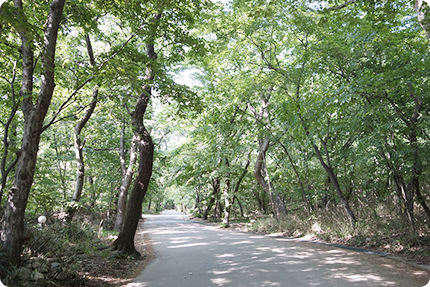 Beopjusa Ori Forest Trail
Beopjusa Ori Forest Trail
- One of the major trees include the Manchurian linden showing lateral symmetry, centering on the Twin-lion Stone Lantern in front of Daeungbojeon Hall. This tree was planted on the site in the unified Silla period so that the monks could make prayer beads using its fruit. Because it bears resemblance to the Indian bo tree under which the Buddha attained enlightenment, it is called the “Bo Tree” by the monks of Beopjusa Temple. There are two fir trees standing at 27m tall and boasting a trunk circumference of 2.5m found in front of Cheonwangmun Gate. They blend well with the central axis of the temple extending from Daeungbojeon Hall to Geumgangmun Gate, adding a more magnificent appearance to the temple.
-
-
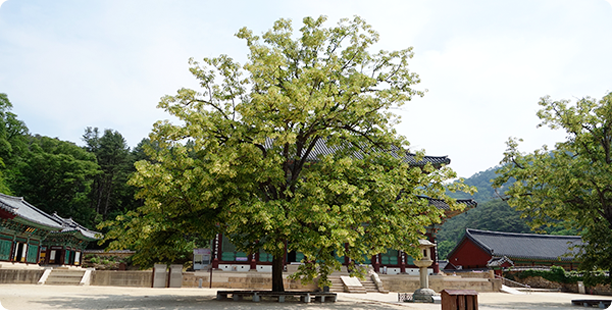 Manchuria linden in front of Daeungbojeon Hall
Manchuria linden in front of Daeungbojeon Hall
-
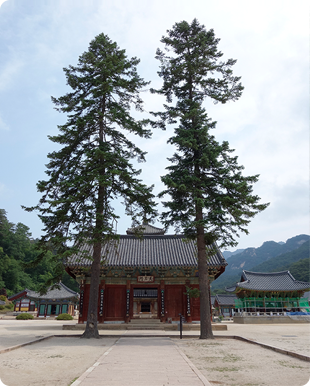 Fir tree in front of Cheongwangmun Gate
Fir tree in front of Cheongwangmun Gate
-
